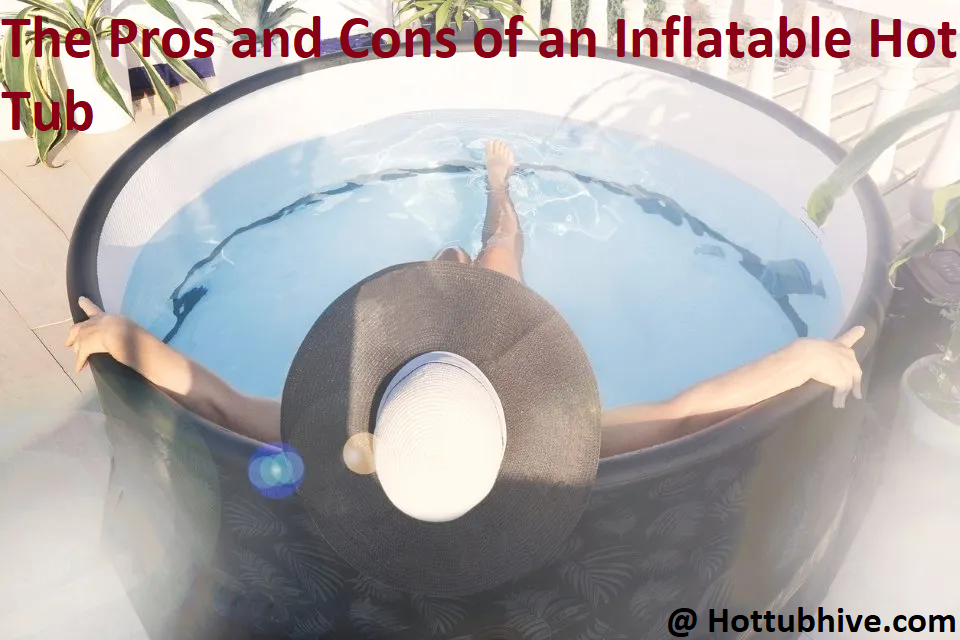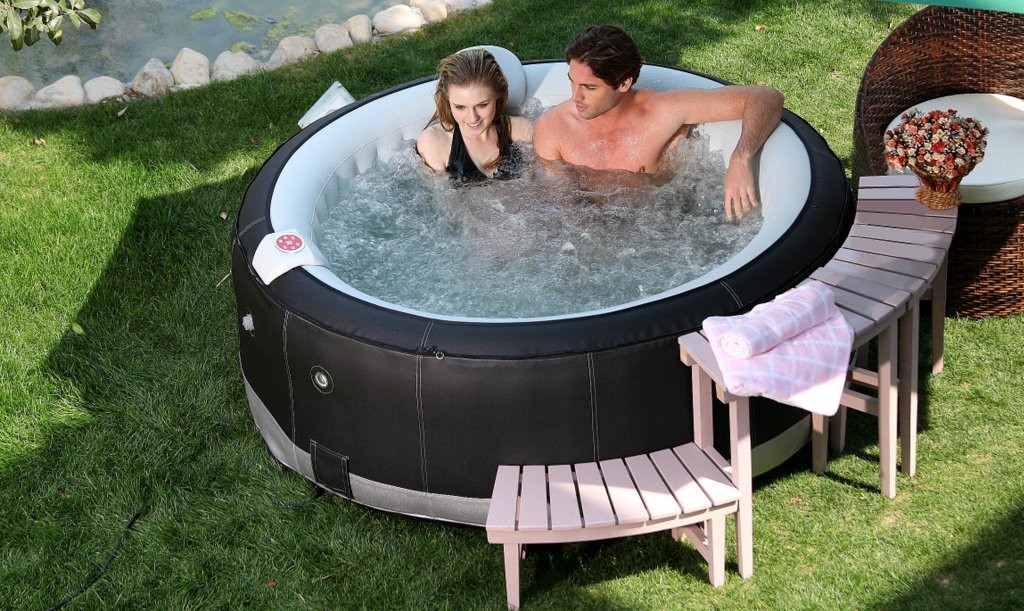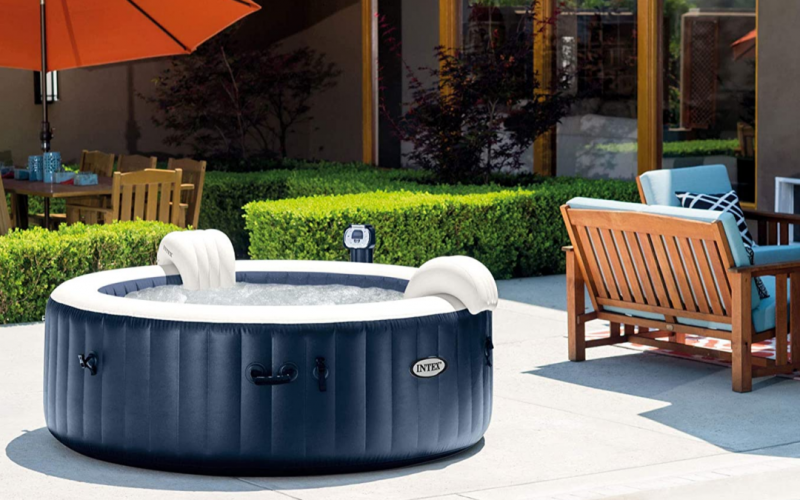Are you considering getting an inflatable hot tub to relax in your own backyard? It’s not a decision you should take lightly. Before taking the plunge and making a purchase, it’s wise to consider the pros and cons of an inflatable hot tub.
In this article, we’ll give you a complete guide to help you make an informed decision. So, let’s dive in and explore the benefits and drawbacks of owning your own inflatable hot tub!

Inflatable hot tubs are a great option for those looking to enjoy all the benefits of a regular spa but do not have the space or financial budget to accommodate it. These hot tubs range in size, features, and cost—meaning there is an inflatable hot tub suited for everyone. In this complete guide, we will discuss everything that goes into owning an inflatable hot tub.
We will explore the pros and cons of owning one, how they compare to traditional spa options, important safety considerations to take into account when purchasing and installing an inflatable hot tub, and how to take care of one after purchase. Furthermore, we will explore the best ways to utilize an inflatable hot tub depending on usage scenarios such as entertaining visitors or simply relaxing after a long workday.
By exploring all of these components, readers will have everything necessary for making an informed decision about whether investing in an inflatable hot tub is right for them.
Explanation of what an inflatable hot tub is
An inflatable hot tub is designed to provide the same therapeutic massage, temperature control and ambiance as a regular spa or hot tub. However, unlike traditional spas and hot tubs that are made from hard materials such as acrylic or fiberglass, an inflatable hot tub is made of fabric-like material and is filled with air.
Inflatable hot tubs come in various shapes and sizes, making them convenient for smaller spaces. They also offer a more economical alternative to permanent spas and are much easier to install than traditional models. An inflatable hot tub can be filled using either garden hose water or treated tap water, depending on the model you purchase.
In addition to providing comfort, an inflatable hot tub also adds beauty and relaxation to any outdoor space.
Brief overview of the pros and cons
When considering the purchase of an inflatable hot tub, it is important to be aware of both the pros and cons that come with it. The pros include convenience, portability and cost-effectiveness. Inflatable hot tubs can easily be transported from place to place and set up for use almost anywhere. They can also be more cost-effective than permanent hot tubs as there are little-to-no costs associated with installation and maintenance compared to more traditional options. Furthermore, inflatable hot tubs do not need to be professionally installed, making them a great choice for DIYers and budget consciousness individuals alike.
On the other hand, some of the cons that come with an inflatable setup include diminished structural integrity, insulation issues, increased noise levels and potential puncture risks. As they rely on air rather than solid construction materials such as wood or steel, they may sag over time resulting in diminished structural integrity. Furthermore, heat loss due to leakage or poor insulation may lead to costly energy bills in order to maintain a desired temperature inside the hot tub. Additionally, some users have found that the motors used on inflatable hot tubs produce loud noises while running which can pose a nuisance when trying to relax outdoors or indoors if kept indoors during colder climates. Finally, due to their soft nature they are prone to punctures or accidental tears which could lead to an expensive repair down the line.
Pros of an Inflatable Hot Tub
An inflatable hot tub can be an affordable and convenient solution for getting a spa-like experience in the comfort of your own home. While it’s not going to offer all of the features that a more permanent, hard shell hot tub will, they do offer some advantages. The following are some of the many pros of having an inflatable hot tub:
- They are more affordable than traditional hot tubs – An inflatable hot tub tends to cost less than a standard one due to their temporary nature and lack of additional features. This makes them great for people on a tight budget or who don’t have much space to work with.
- They provide quality relaxation – Despite their temporary nature, inflatable hot tubs provide just as much quality relaxation as regular ones do. The water is usually kept at an optimal temperature (just like any other type of hot tub) and you can also enjoy all the classic spa accessories like aromatherapy and massage jets.
- Easy transportability & setup – One of the best things about this type of natural spa is its portability factor. Since it’s made up entirely out of air, you can easily move it when you need to—from one room in your house to another or even between properties if needed—and setup only takes minutes before you can enjoy it! Plus they come with everything you need including all the fixtures & fittings necessary for setup and installation in almost no time at all.
Affordability compared to traditional hot tubs
Inflatable hot tubs offer the advantages of traditional hot tubs at a fraction of the cost. More often than not, a new inflatable hot tub will cost between $400 and $1000 dollars, while a traditional hot tub can set you back several thousands of dollars. This makes an inflatable hot tub much more affordable than buying one outright or even renting one long term.

In addition to the initial costs, there are also ongoing costs that need to be taken into consideration when looking at traditional versus inflatable hot tubs. Traditional hot tubs require electrical hook up for installation and expensive monthly maintenance costs for proper water filtration and balancing. Inflatable hot tubs do not require such additional hardware for installation and only require chemical treatments in order to keep the water clean and healthy. These chemical treatments are much less expensive than required maintenance for a traditional spa.
Easy installation and portability
An inflatable hot tub is an option that binds the benefits of a traditional hot tub to the convenience and flexibility of an inflatable pool. It allows you to set up a luxurious tub in any setting you desire, whether it be on a terrace, patio or garden — without any permanent installation. Inflatable hot tubs are also easily transportable when deflated, allowing you to take them with you wherever you travel. Some even come with their own travel bag!
The simple setup process allows anyone to set up the inflatable hot tub in just a few minutes – no tools required! You simply need to place the hot tub on a flat surface and start filling it with water. Once ready for use, just determine where you want the filter system and plug it into an electrical outlet for power. That’s it – now sit back and relax in your personal oasis!
In addition to easy installation and portability, another great advantage of having an inflatable hot tub is that they require less upfront investment than conventional models. This can make them especially attractive if your budget is tight or if you don’t want to commit too much money into a permanent installation — like if you plan on moving soon or if only plan on using it during certain times of year (like the summer). Inflatable hot tubs can offer substantial financial savings over conventional models, particularly when factoring in ongoing maintenance costs.
Versatility in terms of placement and usage
Inflatable hot tubs offer unbeatable versatility in terms of placement and usage. Not only are they easier to transport than traditional hot tubs, but they can easily be set up indoors or outdoors in a matter of minutes. The combination of durability and portability makes it possible to bring your inflatable hot tub virtually anywhere — on camping trips, beach excursions, the backyard, poolside or even the living room! This level of mobility is hard to beat and provides you with an unmatched level of freedom when it comes to enjoying the relaxing power of a hot tub.
In addition, inflatable hot tubs are perfect for use as either an individual or shared experience – making them incredibly versatile for families or couples who want to enjoy some quality time together at home. They also prove ideal for soaking away aches and pains after a hard exercise session without having to switch from one location or device to another. And thanks to their countless adjustable features (e.g., temperature, jets and seating), you can create the perfect environment for whatever type of relaxation experience you’re looking for – whether it’s solo-time spent reading in silence or a social gathering where friends can let off some steam by chatting about the latest TV show!
Lower maintenance and operational costs
Inflatable hot tubs are becoming increasingly popular due to their comparatively low cost and low maintenance requirements. In comparison to a traditional hot tub, an inflatable one offers several advantages in both cost and upkeep.
Cost of Purchase: An inflatable hot tub is considerably less expensive than a traditional model. This can make them appealing for those who want the experience of a hot tub but don’t want to invest as much money into it.
Cost of Upkeep: Contacting a professional for regular maintenance checks on a traditional model can be costly and time consuming. With an inflatable pool, all you need to do is hose off the inner walls after each session, replace the filter periodically, and keep the cover secured when not in use to reduce heat loss.
Energy Efficiency: With technological advances having been made in recent years, some inflatable models have been designed with energy-saving technology that can significantly reduce your energy bill over time by using less electricity than standard models.
Installation: Unlike permanent installations, an inflatable hot tub requires no special tools or permits as it connects directly to your home’s power source such as a standard outdoor outlet. All you need is a level flat ground surface for setup and you’re ready to go!
III. Cons of an Inflatable Hot Tub
Though an inflatable hot tub comes with its own set of advantages, there are also a few drawbacks that deserve attention. Below are some of the common cons for inflatable hot tubs that you should consider when making your purchasing decision:
- Low water capacity – Generally speaking, an inflatable hot tub will have a lower water capacity than traditional non-inflatable tubs. This means that the water must be changed and cleaned more often.
- Not as strong durability – Inflatable hot tubs may not last as long or be as durable as skins lined with hard plastic or fiberglass shells. It is important to take good care of your hot tub if you want it to last a long time and to buy from reputable suppliers to ensure quality materials in construction.
- Higher price tag – Inflatable hot tubs may cost more than their non-inflatable counterparts, given the fact they require regular maintenance, replacement parts and special pumps/filters/sanitizers for optimal operation and safety.
Durability and lifespan concerns
Inflatable hot tubs are gaining in popularity due to their convenience and relatively low cost. But if durability and lifespan are top concerns when it comes to purchasing a new hot tub, then you may want to consider the advantages and disadvantages of inflatable hot tubs in comparison with more permanent solutions.
One of the biggest advantages of an inflatable hot tub is its sheer portability. Since it is designed to be inflated, deflated, moved and stored easily no matter where you live or how frequently you relocate, it allows for ultimate backyard use flexibility. However, there is a trade-off – while they are more affordable than buying a standard hot tub outright, they do not last as long as traditional spas with proper care and regular maintenance.
Inflatable spas typically have shorter lifespans than other types of hot tubs as the material used for construction may not be as robust or able to withstand wear and tear as well as higher temperature settings over extended periods of time. The vinyl may also quickly break down over time due to sunlight exposure or exposure to harsh chemicals like chlorine or bromine–definitely something important to consider if you plan on using the spa outdoors for long periods throughout the year.
Limited features compared to traditional hot tubs
When considering an inflatable hot tub, it’s important to remember that the features may be more limited than those offered with a traditional hot tub. Many of these tubs cannot be used for treatments or massage, as the jets are often too weak and many do not come with a cover that can keep heat in.
Additionally, the interior of the tub is not designed to last as long as a traditional hot tub and can be subject to punctures from homemade additions or from pets. Inflatable hot tubs also require additional setup steps that traditional hot tubs don’t need.
Less insulation and energy efficiency
Inflatable hot tubs often have less insulation than a permanent model leading to lower overall energy efficiency. A lack of insulation means that heat escapes more quickly; thus, your hot tub needs to work harder to maintain temperature and will require more energy. This inefficiency can result in higher monthly bills, depending on how much you use the hot tub.
Additionally, your model may need to be turned up higher than a permanent one due to the lack of insulation, increasing energy bills even further and shortening the lifespan of certain parts such as the heating element and motor.
Difficulty maintaining temperature in extreme weather
Maintaining adequate temperature in an inflatable hot tub can be difficult in extreme temperatures or even with a quality insulated cover. While the pumps and blowers will attempt to maintain heat, any significant variation may require additional measures to retain the desired temperature.

In cold weather, you must use an insulated floating thermal blanket and/or winterizing chemicals. In hot climates, you might need to set a timer during the hottest part of the day so that the pump does not run too long, as it can overheat the water and reduce its heating efficiency. This can be time-consuming and involve regular monitoring of temperatures and adjustments of settings to ensure that both your energy bills and your comfort level stays consistent over time.
Conclusion
After considering all the pros and cons of an inflatable hot tub, it’s clear to see why so many people love to purchase these convenient and affordable spa-like tubs. The ease of use and the portability of an inflatable tub make it perfect for any living space.
It is important to consider your budget and make sure you research reviews from other potential customers before making a purchase. With proper maintenance and care, an inflatable hot tub can be a great addition for your backyard or patio. Keep in mind that investing in accessories such as a cover or ground cloth will help keep your hot tub functional, safe, and clean for years to come.
FAQ’S
Is it worth getting an inflatable hot tub?
It depends on your preferences and needs.
What are the cons of inflatable hot tubs?
They are less durable than traditional hot tubs and may have fewer features.
Do inflatable hot tubs last?
They may last several years with proper care, but are generally less durable than traditional hot tubs.
Are inflatable hot tubs hard to maintain?
They require some maintenance, such as regular cleaning and water treatment, but are generally easier to maintain than traditional hot tubs.
Is it safe to put inflatable hot tub in house?
As long as you have adequate ventilation and follow manufacturer guidelines, it can be safe to put an inflatable hot tub indoors.
What are the disadvantages of a hot tub?
They can be expensive to purchase and maintain, may require professional installation, and can pose some health risks.
Do inflatable hot tubs leak?
They can, but regular maintenance and proper handling can help prevent leaks.
Should I leave my inflatable hot tub on all the time?
No, it is recommended to turn off an inflatable hot tub when not in use to conserve energy.
How often do you change the water in an inflatable hot tub?
It is recommended to change the water every 2-3 months, or more frequently with heavy use.
Is it comfortable to sit in an inflatable hot tub?
Many people find inflatable hot tubs to be comfortable, but it can vary based on personal preference and the design of the hot tub.
See Also-
- Best plug and play hot tub 2023
- Best portable hot tub 2023
- Best vacuum for hot tub 2023
- Best round hot tub 2023
- Best small hot tub 2023
